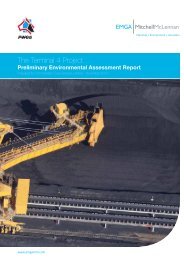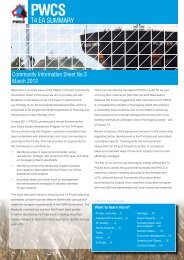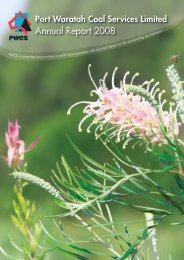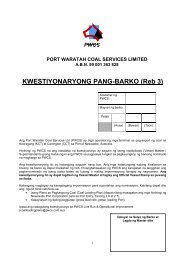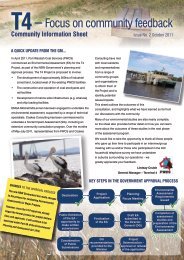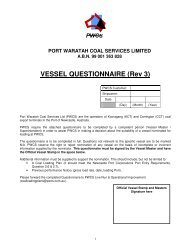Port Waratah Coal Services Limited
Port Waratah Coal Services Limited
Port Waratah Coal Services Limited
- No tags were found...
Create successful ePaper yourself
Turn your PDF publications into a flip-book with our unique Google optimized e-Paper software.
Notes to the financial statementsfor the financial year ended 31 December 2011NOTE 1 SUMMARY OF ACCOUNTING POLICIES USED IN THE FINANCIAL STATEMENTS (continued)Standards and Interpretations in issue not yet adoptedInitial application of the following Standards and Interpretations is not expected to have any material impact to the financial report ofthe consolidated entity and the company:Standard/InterpretationAASB 2010-6 'Amendments to Australian AccountingStandards - Disclosures of Transfers of FinancialAssets'AASB 2010-8 'Amendments to Australian AccountingStandards - Deferred Tax: Recovery of UnderlyingAssets'Effective for annual reportingperiods beginning on or after1 July 20111 January 2012Expected to be initially appliedin the financial year ending31 December 201231 December 2012The Directors anticipate that the adoption of these Standards and Interpretations in future periods will have no material financialimpact on the financial statements of the company or the Group, as the issue of the above noted Interpretations do not affect itspresent policies and operations.These Standards and Interpretations will be first applied in the financial report of the Group that relates to the annual reportingperiod beginning after the effective date of each pronouncement, which in all cases will be the Company’s annual reportingperiod beginning on 1 January 2012 or later.Principles of ConsolidationThe consolidated financial statements are prepared by combining the financial statements of all the entities that comprise theconsolidated entity, being <strong>Port</strong> <strong>Waratah</strong> <strong>Coal</strong> <strong>Services</strong> <strong>Limited</strong> (the parent entity) and its subsidiaries as defined in AccountingStandard AASB 127 ‘Consolidated and Separate Financial Statements’. A list of subsidiaries appears in Note 26 to thefinancial statements. Consistent accounting policies are employed in the preparation and presentation of the consolidatedfinancial statements.On acquisition, the assets, liabilities and contingent liabilities of a subsidiary are measured at their fair values at the date ofacquisition. Any excess of the cost of acquisition over the fair values of the identifiable net assets acquired is recognised asgoodwill. If, after reassessment, the fair values of the identifiable net assets acquired exceeds the cost of acquisition, thedeficiency is credited to profit and loss in the period of acquisition.The consolidated financial statements include the information and results of each subsidiary from the date on which thecompany obtains control and until such time as the company ceases to control such entity. Control is achieved where thecompany has the power to govern the financial and operating policies of an entity so as to obtain benefits from its activities.In preparing the consolidated financial statements, all intercompany balances and transactions, and unrealised profits arisingwithin the consolidated entity are eliminated in full.Financial AssetsInvestments are recognised and derecognised on trade date where purchase or sale of an investment is under a contract whoseterms require delivery of the investment within the timeframe established by the market concerned, and are initially measured atfair value, net of transaction costs.Subsequent to initial recognition, investments in subsidiaries are measured at fair value. Subsequent to initial recognition,investments in associates are accounted for under the equity method in the consolidated financial statements and the costmethod in the company financial statements.Other financial assets are classified into the following specified categories:- loans and receivables- financial assets at cost.Loans and receivablesTrade receivables, loans, and other receivables are recorded at amortised cost less impairment.Interest and dividendsInterest and dividends are classified as expenses or as distributions of profit consistent with the Statement of Financial Positionclassification of the related debt or equity instruments.Shares at fair valueThe company has an investment in an unlisted entity whose shares are not traded in an active market. This investment hasbeen classified as 'shares at fair value - other corporations' (because the Directors consider that the fair value can be reliablymeasured). Fair value has been determined in accordance with generally accepted pricing models based on discountedcashflows. Gains and losses arising from changes in fair value are recognised in other comprehensive income and accumulatedin the fair value of equity instruments reserve. Where the investment is disposed of or is determined to be impaired, thecumulative gain or loss previously accumulated in the fair value of equity instruments reserve is not reclassified to profit or loss.Dividends on shares held at fair value are recognised in profit or loss when the company's right to receive dividends isestablished.23



